

SMBNext: The Lost Levels is a huge collection of cut content that spans around three years of development. This page serves to guide you through this collection's playable stages, with some behind-the-scenes development insight being sprinkled in along the way.
Note that these levels have since been cut from the final game, and therefore do not hold up to our current
standard of quality. Levels are also out-of-order, and do not match what you may see on the world map.
Please keep this in mind while playing.
Without further ado, let's-a-go!
Due to the extreme difference in quality between Part 1 & Part 2, SMBNext: The Lost Levels was split into two parts. You will need a modded 3DS system (or Citra) to play this romhack. Download links are below:
SMBNext: The Lost Levels - Part 1 (Pre-2018 unpolished stages)
SMBNext: The Lost Levels - Part 2 (2018 Trailer Stages)
In addition to the game, you can also listen to a sound selection of music from SMBNext: The Lost Levels, available for download below, in both FLAC & MP3 formats:
For Citra:
1. In Citra, right click NSMB2 in the game list, and select "Open Mods Location".
2. Download and extract the part you want to play.
3. Copy the "romfs" folder from the newly extracted folder into the folder Citra opened earlier.
For 3DS:
NOTE: If you have already played other NSMB2 mods, make sure to delete the Luma directory for your NSMB2 TitleID before proceeding.
1. If it isn't already, set your 3DS up with Luma3DS by following the 3DS hacking guide here.
2. Enable game patching by holding SELECT on 3DS boot, ticking the "Game patching" box, and pressing START.
3. Insert your 3DS SD card into your PC, and find your TitleID version from the list below.
NSMB2 Standard Edition:
EUR - 000400000007AF00
USA - 000400000007AE00
JPN - 000400000007AD00
KOR - 00040000000B8900
NSMB2 Gold Edition:
USA - 0004000000137E00
NSMB2 Special Edition:
EUR - 0004000000137F00
JPN - 0000400000137D00
4. Download and extract the part you want to play, and copy the "romfs" folder to SD:/luma/titles/[TitleID]/.
5. Example directory (for USA Gold): "SD:/luma/titles/0004000000137E00/romfs/Course, Unit, etc".
NOTE: If the "titles" folder does not exist, create it!
6. Turn on your 3DS, with your SD Card inserted, and launch your copy of NSMB2.
NOTE: SMBNext: The Lost levels will persist until you remove or rename the "romfs" folder.
Please use the rest of this page to guide you through playing SMBNext: The Lost Levels.
The first part of SMBNext: The Lost Levels is comprised entirely of levels developed pre-2018, back when what is currently SMBNext was known simply as "New Super Mario Classic". These stages have aged rather poorly compared to later levels and were created when we didn't have a uniform approach to level design.
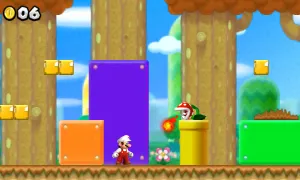
Originally, NSMB2's rainbow stages were to be replaced with stages from other 2D Mario games re-created in the given world's theme.
This one in particular is a remake of 1-1 from Super Mario Bros. 3, albeit set in an autumn environment.

A staple in any 2D Mario game, the first level is usually a great way to introduce the player to the game. The same can't really be said about this level, which sends three enemies your way right from the start.
One of the earliest stages ever made, and also one of the first to be replaced.

An underground level that uses Piranha Plants and Donut Lifts. Camera movement and tiling in this stage are very janky, as was typical for early custom levels.
Later on, this level would go on to receive many revisions.

This is an athletic stage themed around mushrooms and Koopa Paratroopas. As with the underground level, it's very rudimentary and features some questionable Star Coin placement.
As with many other stages, 1-3 received more revisions.
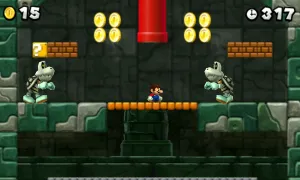
New Super Mario Classic's first tower is a Dry Bones-filled mess, with a camera that doesn't lend itself well to vertical scrolling.
1-Tower also features fences with tops, for some reason.

This stage is (supposedly) another revision of 1-1, this time appearing to ditch spider webs in favor of a more generic introductory level.
However, there are still many long pits placed around the level, which frequently interrupts gameplay.
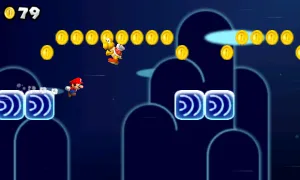
A fairly simple cannon level. At this stage of development, we had not experimented much with using NSMB2 's Rush Cannons.
As such, this stage features a few easily preventable gameplay mistakes, such as the player having to jump during the Rush Cannon's initial speed-up phase.
 An underwater stage (which starts off similarly to 1-2) that focuses primarily on Cheep Cheep rings.
An underwater stage (which starts off similarly to 1-2) that focuses primarily on Cheep Cheep rings.
When this level was created, object data for these rings hadn't been completely figured out yet, so all ring instances in this level were copy-pasted from NSMB2 stages.
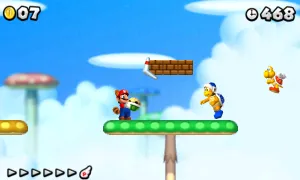
The original 1-A. This level was remade countless times during development, and to this date remains the stage with the most revisions (next to 1-1).
There are a few different types of enemies in this level, including Fire Bros. and Boomerang Bros.
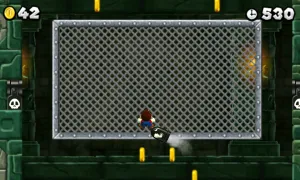
Rather than a castle, this level is just another revision of 1-Tower. Instead of Koopa Paratroopas, this level uses Bullet Bills.
One interesting thing to note is that homing Bullet Bills (which are used in this stage) went unused in NSMB2. They do not produce any particle effects upon exploding, and do not flash red as they come closer to their demise.
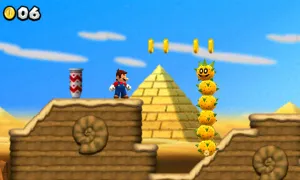
A remake of 2-1 from New Super Mario Bros. DS. The tileset used for this level (and others in World 2) was ported over from New Super Mario Bros. U.
Unlike the first rainbow stage, this remake sticks closer to the original level, with very little layout changes.

The beginning of World 2 was originally intended to be an oasis, leading into a proper desert later on.
This stage in particular showcases that; matching the desert tileset with log platforms and water. It was scrapped for multiple reasons; one being that we changed design direction for the second world later in development.

A continuation of the previous oasis stage, 2-2 features more grassy terrain, as well as the Porcupuffer.
This level is rather simplistic in design, and also very repetitive, with a never-ending gauntlet of log platforms.

As you'll quickly learn within the first few seconds of starting this level, this stage prominently features Fire Snakes.
Contrary to the previous two stages, 2-3 shows what the main part of World 2 would have looked like, getting rid of the oasis theme in favor of sprawling sands.
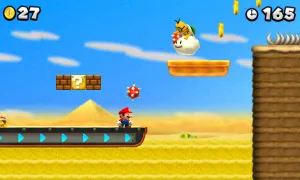
Another desert stage; this time featuring the one-way platform originally used in a castle stage in NSMB2.
Quicksand takes the place of lava, but as you can tell, the two gameplay mechanics do not mix very well, resulting in a very awkward experience.
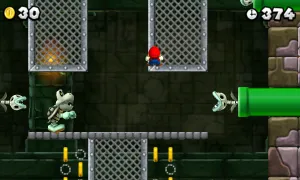
This tower stage features a slightly more yellowed-out tileset, indicating that it was to be used in World 2.
It also uses a lot of Dry Bones, as well as a few dark red moving platforms. One somewhat interesting thing to note is that the second area of this level is horizontal, despite being a tower.
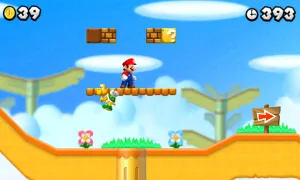
Despite seemingly being a ghost house, this stage is actually a totem-themed athletic level.
It was most likely going to be used for World 2, and is somewhat notable for using rotating coins, a gameplay mechanic which is now used frequently.

There isn't much in this stage that's different from the other oasis levels, with its only defining feature being that beach huts from New Super Luigi U are used.
Due to SMBNext not supporting Layer 0 at the time, the beach huts are rendered behind Mario, instead of in front of him.
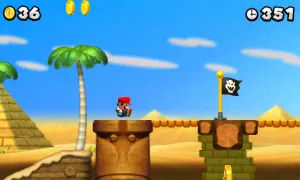
The third main desert stage; this level doesn't have a clear focus, with enemies placed at random.
However, this level prominently features moai statues that the player can ground pound to "lower". Because SMBNext had no Magic Lifts at the time, the statue disappears instead of properly lowering.

Another underwater stage: this one focuses more on purple Cheep Cheeps and Bloopers.
Cheep Cheep rings still had very little usable object data at this point in time, so they are very tightly spaced, leaving the player very little room to swim past.
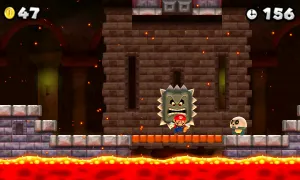
An early revision of 1-Castle which used Thwomps in rather uninteresting ways.
All in all, it's a fairly basic castle stage, with nothing that really sticks out. It was quickly scrapped a few months later.
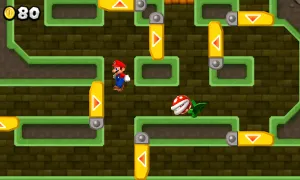
A remake of 2-3 from New Super Mario Bros. DS, albeit styled a little differently, and without manholes.
This stage uses a custom sewer tileset that was adapted from NSMB2's totem tileset. As with most other stages, the camera doesn't control very well (as we hadn't figured out how to properly set up camera boundaries yet).
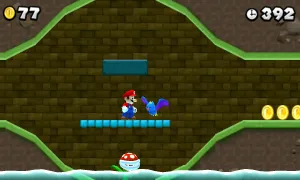
The first stage of New Super Mario Classic's sewer-themed world. During development at this time, one level designer was very keen on using the exact same slope + ? Block combination to begin all of their stages.
This level marks the first appearance of the dreaded slope combo.
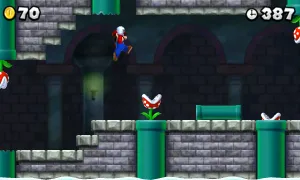
This stage is the very first revision of Sewer World's castle. Pipes are used frequently, and at times the sewer tileset is combined with the castle tileset in order to try and evoke some variety.
Unfortunately, this level, like most levels around this time, did not quite meet that standard.
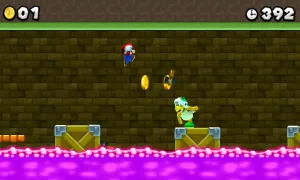
A sewer stage that uses poison water and wooden crates. It is notable for two things:
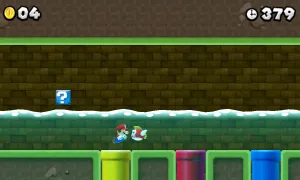
This stage starts off just like the previous level, except this time, it contains water rather than poison.
Fun fact: This stage is the same section copy-and-pasted a few times. Ironically, this level succeeds at making you feel like you're exploring a sewer, with how monotonous it is.
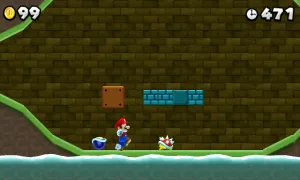
Just like the last level, this one also features a lot of copy-pasted sections.
It also features Buzzy Beetles that drop from the ceiling, which marks one of the few times they have ever been used in SMBNext.
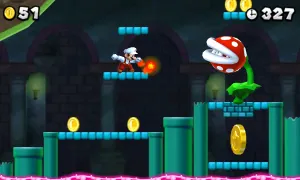
The second revision of sewer world's castle; this stage improves on what made the first more mundane.
Piranha Plants are used in a greater variety of ways; now seen standing on top of moving platforms. Star Coins aren't placed as haphazardly anymore, and overall the stage is more focused.
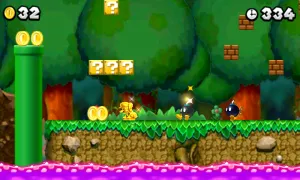
This stage is a remake of Forest of Illusion 3 from Super Mario World.
In place of Bob-ombs in bubbles, Para-bombs are used instead. There was originally a stupidly tall pipe in the middle of the level, but a block was later added to address this issue.

One of the more polished forest stages; 3-1 focuses on spider webs and Scuttlebugs.
This is also the first variation of this stage, which was eventually scrapped in favor of a different mechanic entirely.
The New Super Mario Bros. U jungle tileset is also used.

A perplexing blend of underground and sewer theming, this stage features some bizarre gameplay involving Wigglers, including bouncing off them while they sit half-submerged in poison.
Other than that, this stage is fairly generic.
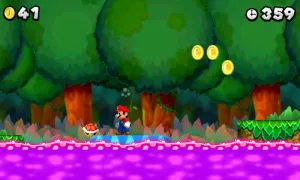
Beginning with yet another generic slope combo, this level utilizes mushrooms that go up and down depending on their color.
This is one of the more interesting mechanics in NSMB2 (despite it being pulled directly from NSMBDS), which resulted in it being used in many early SMBNext levels.

This level features a ported version of the ruins tileset from the popular romhack Newer Super Mario Bros. Wii.
Interestingly, it also directly borrows level concepts from one of the original levels that tileset was used in, Tangle Temple.

Moderately better than the Rush Cannon stage in World 1, this level uses more of the same enemies and platforms.
This is also one of the last dedicated Rush Cannon levels ever made for SMBNext.
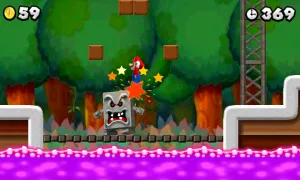
One of the later airship stages made for New Super Mario Classic, which was rather quickly scrapped later in development.
Other than the original Halloween Special, this was one of the first stages in SMBNext that used Whomps.
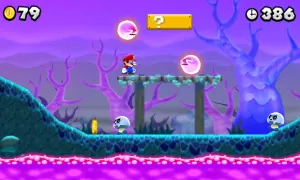
A ghostly forest level. Outside of a few magically appearing objects, this stage is very basic, only prominently featuring some Boos and Bone Goombas.
Fun fact: Did you know that Bone Goombas have an alternate texture that goes unused in NSMB2?
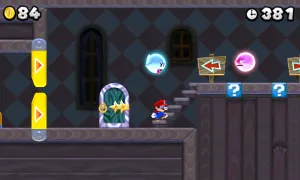
One of the only ghost house stages ever created for SMBNext, 3-Ghost House features a maze of doors that the player must traverse through in order to gain access to the right ? Switch.
It also contains a secret exit.

A jungle ruins-themed tower. There are quite a few bugs in this level, such as being able to warp the Whomp higher than it's supposed to be (pictured right).
If you can get past the problematic camera, this is one of the more polished stages made pre-2018, if not a little uninteresting.
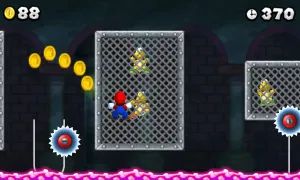
This stage uses chain-link fences in tandem with grinders, as part of a somewhat anticlimactic castle for a jungle-themed world.
In addition to that, the background for this level was originally a normal jungle backdrop, but was changed later to a castle.

Despite being tiled incorrectly, this stage is in fact mountain-themed. It also features Paragoombas, as well as some other general-purpose enemies.
The tileset used in this level is from New Super Mario Bros. U, like many SMBNext tilesets at the time. Nowadays, every tileset used in SMBNext is entirely original (and fully 3D-modeled).
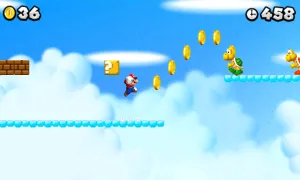
This stage, despite where it's located, is actually the second revision of 1-A.
There isn't much else different here other than fixes to a bonus room inspired by Super Mario 3D Land.
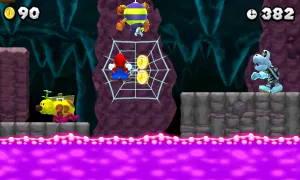
A level that takes place in a purple poison cavern; this stage is actually rather deecnt given the time period during which it was created.
Scuttlebugs and spider webs are used to great effect in this stage, and while it isn't mind-blowing by any stretch, this level gives a glimpse into SMBNext's future approach to level design.

A fairly mundane level consisting of tall pipes with Piranha Plants and Fire Piranha Plants. This level is also mountain-themed, but it's not very interesting otherwise.
Bizarrely, there are ? Blocks scattered throughout the level on the ground near certain pipes. Their purpose is unclear.
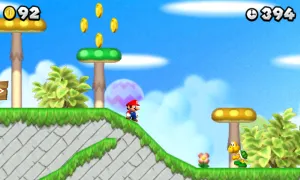
This level is actually another revision of 1-3; removing the donut lifts in favor of using Boomerang Bros. more prominently.
Overall, the level is marginally more focused than the first revision, but it still went through many, many redesigns before turning into the final version used today.

A sunset mountain level that uses a lot of Piranha Plants. There are also plenty of mushroom platforms to play around with.
An interesting thing to note about NSMB2 is that the mushroom platforms are tiles instead of objects, so they do not tilt when Mario lands on them. However, the few moving mushroom platform objects that exist do.

This stage is set in the snowy mountains, using stretching mushroom platforms as its main gameplay mechanic.
Like most other stages, this one was also replaced.
This is a good time to mention Piranha Plant hitboxes in NSMB2. They are very, very large, and Piranha Plants can often hit you from quite a bit away.

4-5 features Mario as a snowman, a ton of Goombas, and then some random colored pipes near the end.
It should be rather self-explanatory why this stage was eventually scrapped.
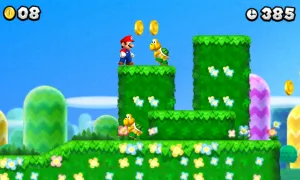
The opposite of a castle, this is just a grassy stage that was intended to be the first level of Sewer World, back when it wasn't a sewer.
Interestingly (not), this stage is designed in the same vein as a typical introductory level, albeit with a lot more enemies.

One of the final versions of 1-1. This was the last revision of the level before it was redesigned once more for the last, final (truly final this time, we promise) version of 1-1.
This revision actually places spider webs on top of trees.

An earlier revision of 1-2. Interestingly, this revision adapted the first revision of 1-2 into a more focused stage, while simultaneously making the camera work more smoothly.
This stage also features bouncy checkerboard blocks ala New Super Mario Bros. Wii, which are just tiles using collision from the Invisible Ghost House Block.

Yet another revision of 1-A, this stage uses the tried-and-true combination of rail-controlled platforms and Fuzzies.
There aren't too many notable sections in this stage, but it's one of the more polished levels from late 2017.
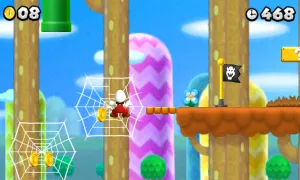
This is an earlier revision of 1-1, in which there's a bug where you can see the coins in mid-air before they rotate in.
Certain sections of this stage are different, and spider webs float in mid-air instead of being attached to a tree.

As opposed to the previous level, which is another revision of 1-1, this level is actually an early version of 1-4, replacing the version before it.
This stage is very similar to the one used in one of the older New Super Mario Classic demo packages.

This level is an underwater stage that was intended to replace the previous version of 1-5.
As a whole, this level has a much clearer focus than the earlier revision, using water flows to push the player around.
This mechanic would go on to be used frequently in the final revision of SMBNext, as a means to speed up otherwise-slow underwater gameplay.
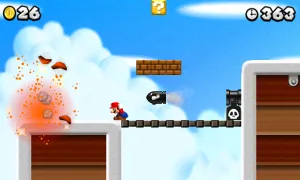
This stage starts with a "scenic" entrance room, which while rather sloppily done, set an example going forward.
This rest of this level comprises of a fairly basic airship level, using Bob-ombs in place of other airship enemies/hazards like Mecha-koopas and cannonballs.

An introductory jungle stage, 6-1 was the first major stage to introduce a "twist" near the half-way point. It was also the first time rotation-controlled coins were considered for commonplace use in SMBNext.
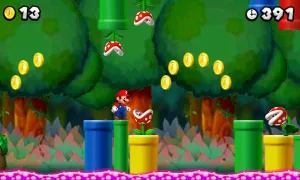
A cramped jungle stage that revolves around Piranha Plants in pipes.
This is a very groundbreaking mechanic that has never been used this way before (not). To make matters worse, there are long pits of poison between every pipe.

A mineshaft-themed level featuring... barrels. There really isn't that much else notable in this stage.
Certain sections of this stage also may or may not have been copy-and-pasted.

At the very beginning of this stage a Goomba approaches, but is soon interrupted by rising poison that insists on giving it a poison bath.
After that, this level is more of the same, with donut lifts placed in-between pipes.
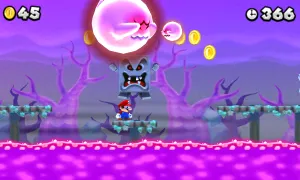
Another ghost stage; this time slightly more desolate.
Boos, Whomps, Dry Bones, and Bone Goombas are all used consistently in this stage, but there isn't much else to grab the player's attention.

This one is a little bit like the Painted Swampland stage from New Super Mario Bros. U, but without any of the painted swamplands (or fun).
Instead, what you see is what you get, with barrels and pipes haphazardly placed throughout the level, making it rather difficult to clear.

An earlier revision of the jungle stage with crates and rising poison water.
Most of this level's difficulty comes from the Piranha Plants densely placed together, along with the various Fire Piranha Plants standing on crates.
The second part of SMBNext: The Lost Levels is comprised mostly of stages that were developed early to mid-2018. This "era" of SMBNext was featured in the 2018 reveal trailer, and eventually led to the current revision of SMBNext.
These levels are on average of better quality than the stages in Part 1, but likewise, were largely scrapped. Please keep this in mind while playing.
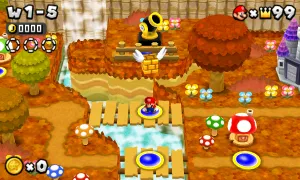
In 2018, the first-ever truly custom world map was completed for SMBNext. The path layout is mostly retained from NSMB2, but the map was modeled entirely from scratch.
Due to World 1's design direction evolving, this map was later scrapped, and a different one (with brand-new paths) is now used instead.

A staple of- oh, this isn't 1-1. The first stage from this time period is actually still in-use today, so this level is instead a revision of the SMBNext demo's 1-4.
Not much was changed in between this revision and the demo's release.

This stage is an alternate revision of 1-5. Created using the guiding idea of having a water level where you never actually go underwater, this stage uses fuzzies on rails to a rather debatable effect.
There's also a Star Coin hidden up a rope, which is pretty sneaky.

A later revision of 1-A, this level prominently features Hammer Bros. and Boomerang Bros.
There are pink mushroom platforms that move erratically, and this stage contains one of the few instances of gold rings from NSMB2 being used in SMBNext.

This stage was intended to be the airship level for World 2. The airship is partly submerged in sand, and the level later leads you underground to the lower parts of the airship.
Scrapped due to World 2 no longer needing an airship level; this is the first time this stage has seen the light of day.

Inspired by New Super Mario Bros. DS's first castle stage, this level uses tightropes in tandem with moving spiked platforms.
This combination actually works rather well, and this level kept its place for quite a while before eventually being replaced with a different stage.

An introductory level from World 2, this level revolves around Whomps, as well as a type of sand simply identified as "slow sand" (because well, it makes you slow).
Granted, this mechanic doesn't make sense in this context, so it was scrapped (only to be re-used later for something else).

This stage features a multitude of colored pipes, as well as some moving platforms and Fire Piranha Plants.
Originally, this stage was intended to be a bonus level for World 2, but it was eventually scrapped because of a change in design direction.

One of the first auto-scrolling stages from this time period, this level takes place in a sandy cave with many fire bars and Fire Snakes.
Two important things were learned from this level:

The opposite of a sandy desert; this level takes place in the snowy hills.
Originally, this stage used Munchers as its main hazard, but due to difficulties getting Munchers to work (while not requiring a patcher) for SMBNext: The Lost Levels, they were replaced with generic spiked blocks instead. Sorry!

A "highlight" from the 2018 trailer, this level takes place in a poison soda lake full
of popsicles.
In case it wasn't immediately obvious, the popsicles in this level were created from royalty-free stock photos, which doesn't look very good. The level itself is ...alright, though.

One of the first levels to use a tileset made from scratch for SMBNext, this is a jungle stage riddled with bouncy mushrooms.
Interestingly, this stage also uses green ? Blocks and Brick Blocks. These were intended for use in the jungle world, but were later scrapped in favor of ordinary blocks.

Another version of the old oasis-styled levels; this revision uses the Porcupuffer together with water that rises and lowers to create a somewhat-interesting level hazard.
Spinies are also shown to turn into little spiny balls upon touching the water, which is a neat little touch on Nintendo's part.

This is a stage that focuses on scale lifts placed around a snowy mountain. The tileset is ported over from New Super Mario Bros. U.
In addition to that, this level has a misleading pit near the end of the level. One pit takes you to the exit, while the other (directly next to it) is marked with an exclamation mark sign and takes you directly to your death.

This is a rather interesting take on the "freezeflame" concept. As opposed to lava directly coming into contact with snow/ice, you switch between different variations of the same level which causes various things to change depending on the environment.
For example, a frozen spiked ball that moves slowly when under icy conditions changes into a rapidly-moving spiked ball when lava is present. This is definitely one of the 2018-era SMBNext's more interesting stages.

A fairly simply desert ruins level that has the player dodging Pokeys and Bone Piranha Plants.
There was a lot of time spent on this level, but it was scrapped a short while later due to being too uninteresting compared to other neighboring stages.

One of the only candy-themed stages made for SMBNext, this level prominently features candy canes that you can climb on.
Much like the popsicle level, this tileset was created using a beta Newer Super Mario Bros. Wii tileset, and quite a few stock photos. In the end, the level ended up being scrapped, with its ideas being re-used later on.

This is another pretty basic desert stage that contains a variety of moving Brick Block platforms and Spike-Tops.
The level was never completely finished, so it ends around what would have been the halfway point.

This level has the honor of being the final stage ever created for Sewer World.
Tower platforms were replaced with a pipe for this level, but due to the model, they appear to have melted. Oops.

A fairly standard water level featuring flowing water and Cheep Cheep. This stage is also one of the first real attempts at a proper underwater level.
Iconic moments include a red ring with its coins placed directly in between two opposite sets of flowing water, making for a frustrating experience.

This stage is largely unfinished, but was intended to be a desert level featuring tightropes over (and under!) Piranha Plants.
Unfortunately, the level didn't go very far before being scrapped early in development.

A rather crude level set in the desert underground, consisting of various moving rectangular desert lifts.
Among developers, this stage is infamous for being one of the most unstable stages ever made. The entire stage had to be re-done in order for it to not crash. Even more bizarrely, at some point this stage featured a green cave tileset, as opposed to the desert one seen now.

One of the more interesting stages created later in development; this level places a focus on spiked balls and conveyor belts.
"Slow sand" also makes a re-appearance here, now adding slopes to the mix. They interact with the spiked balls the way you'd expect them to.

Another unfinished stage, this one is a simple underground cave level featuring Buzzy Beetles, Piranha Plants, and moving platforms.
Strangely enough, despite being unfinished, this level took around 8 months to get to its current state.

This level is ...strange. The first half is a fairly standard ghost-themed level, while the second half adds stretching mushroom platforms and Buzzy Beetles.
The thing is, the second half was actually intended to be used in another level with a completely different theme; snow. How that section got into this level is a mystery to everyone.

A concept we had early on was to have a colored "neon" challenge stage for each world. They would have rewarded you with a Gold Flower, and were generally fairly difficult to complete.
This stage was the only one of its kind ever finished, and the idea was completely scrapped later in development.

What if you had to platform between very fast-moving platforms? This level was designed almost entirely around that idea, making it one of the most challenging stages ever created for SMBNext.
It was scrapped later in development, not only due to the strange difficulty curve, but also because the theming was all over the place.

A level from SMBNext: Halloween Special DX, albeit with normal cave theming. The reason for this stage being used in SMBNext is unclear.
Perhaps it was a placeholder, or maybe it was placed into SMBNext: Halloween Special DX later. We will never know...
Hopefully SMBNext: The Lost Levels gave you a little more insight into the development of this feature-length mod. Please stay tuned for more news and updates on SMBNext in the future.
You can find more sneak peeks and previews over on the official SMBNext Discord Server. We hope to see you there!